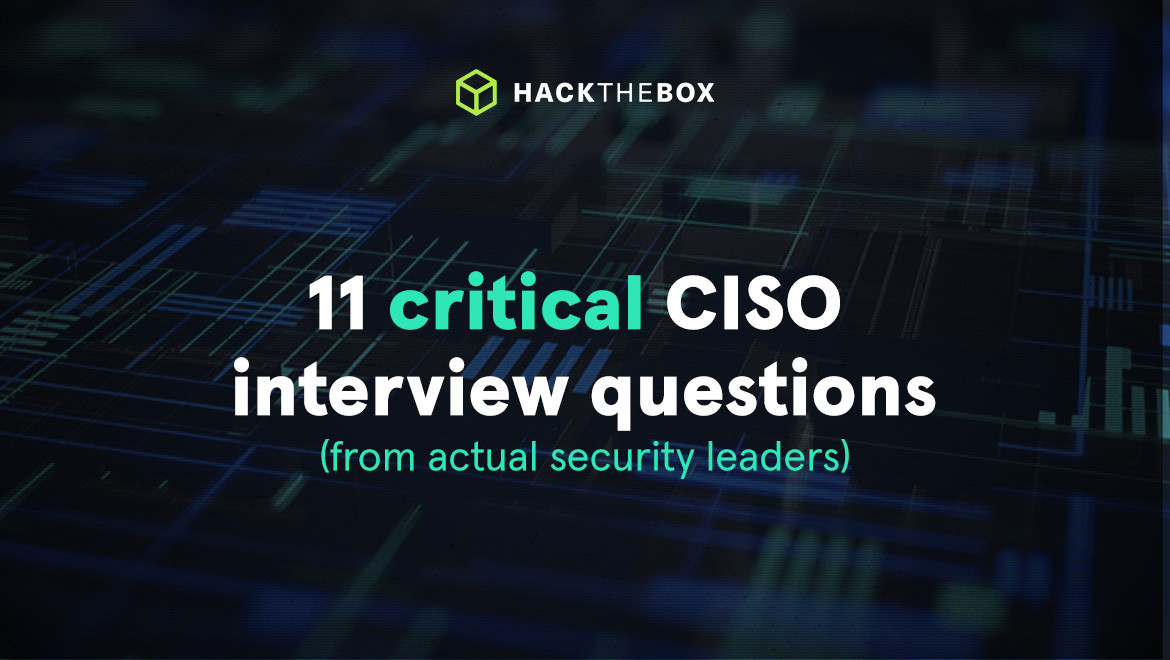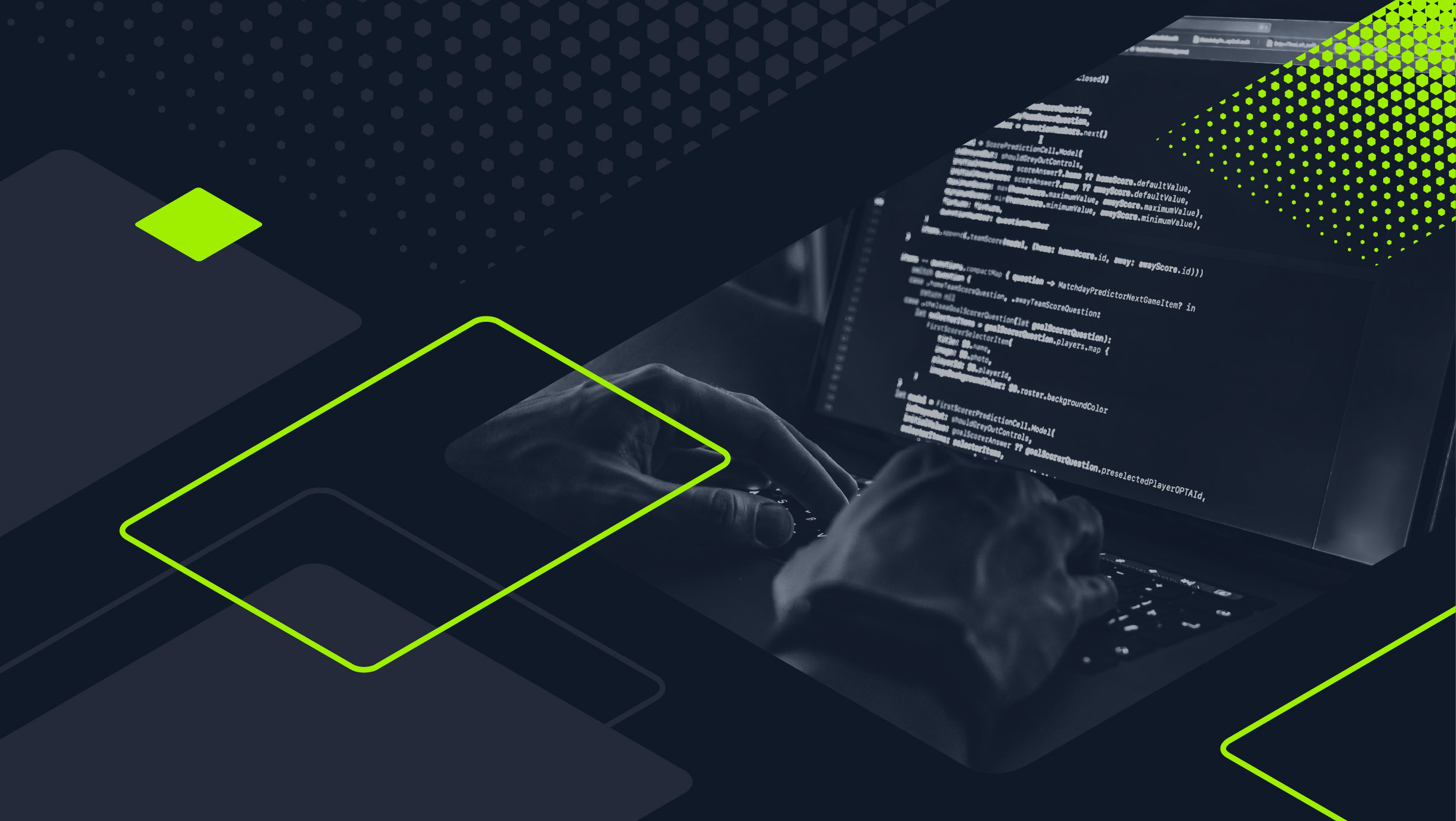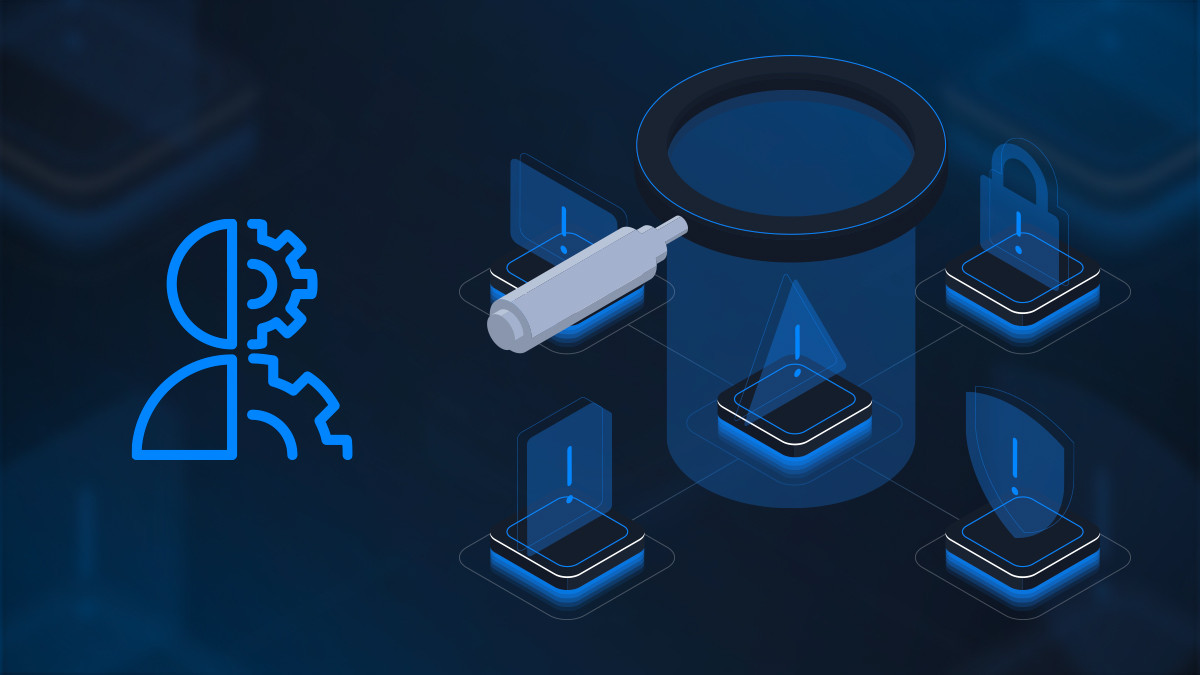CISO Diaries
11 critical CISO interview questions (from actual security leaders)
5 security leaders share the questions they’d ask (or have been asked) in CISO job interviews. Use our guide to prepare for interviews or interviewing candidates.

fileake,
Mar 11
2024
Table of Contents
- Leadership-focused CISO interview questions
- Role-specific security officer interview questions
- 4. How can a CISO strategically elevate the security of third-party cloud infrastructure, effectively mitigating inherent risks linked to shared cloud resources, runtime security, use of FOSS and supply-chain security, and potential physical security vulnerabilities?
- 5. Can you describe a comprehensive strategy you've implemented or would implement to manage and mitigate cyber risks across an organization? Tell me how you would align this strategy with the organization's broader business objectives.
- 6. How do you stay up-to-date with the latest security vulnerabilities and attack techniques?
- 7. How do you effectively communicate cybersecurity updates and needs to board members and key stakeholders?
- CISO soft skills interview questions
- Expert advice from CISOs
- Questions CISOs may ask during an interview
- Cybersecurity needs you!
The end goal of many cybersecurity professionals is to work their way up to becoming a Chief Information Security Officer (CISO).
However, this is no easy feat. A CISO’s role is often a balancing act between mastering technical challenges and excelling in strategic communication and leadership.
It involves not just the safeguarding of an organization's assets but also a proactive approach to threat anticipation, budget negotiation, and the fostering of an organizational culture that prioritizes security.
To successfully hire your next CISO, you need to know the right questions to ask as well as what CISOs themselves are looking for.
We spoke to CISOs, seasoned industry leaders, and hiring managers to discover their top CISO interview questions and how they’d personally answer them.
This guide will help both potential CISO candidates applying for job roles and those tasked with hiring them. It offers:
-
Insights on the cybersecurity job interview processes informed by the personal experiences of industry professionals (who have decades of experience).
-
A list of CISO interview questions and answers to assist hiring managers and job seekers.
-
Example answers that can help candidates understand what employers are looking for.
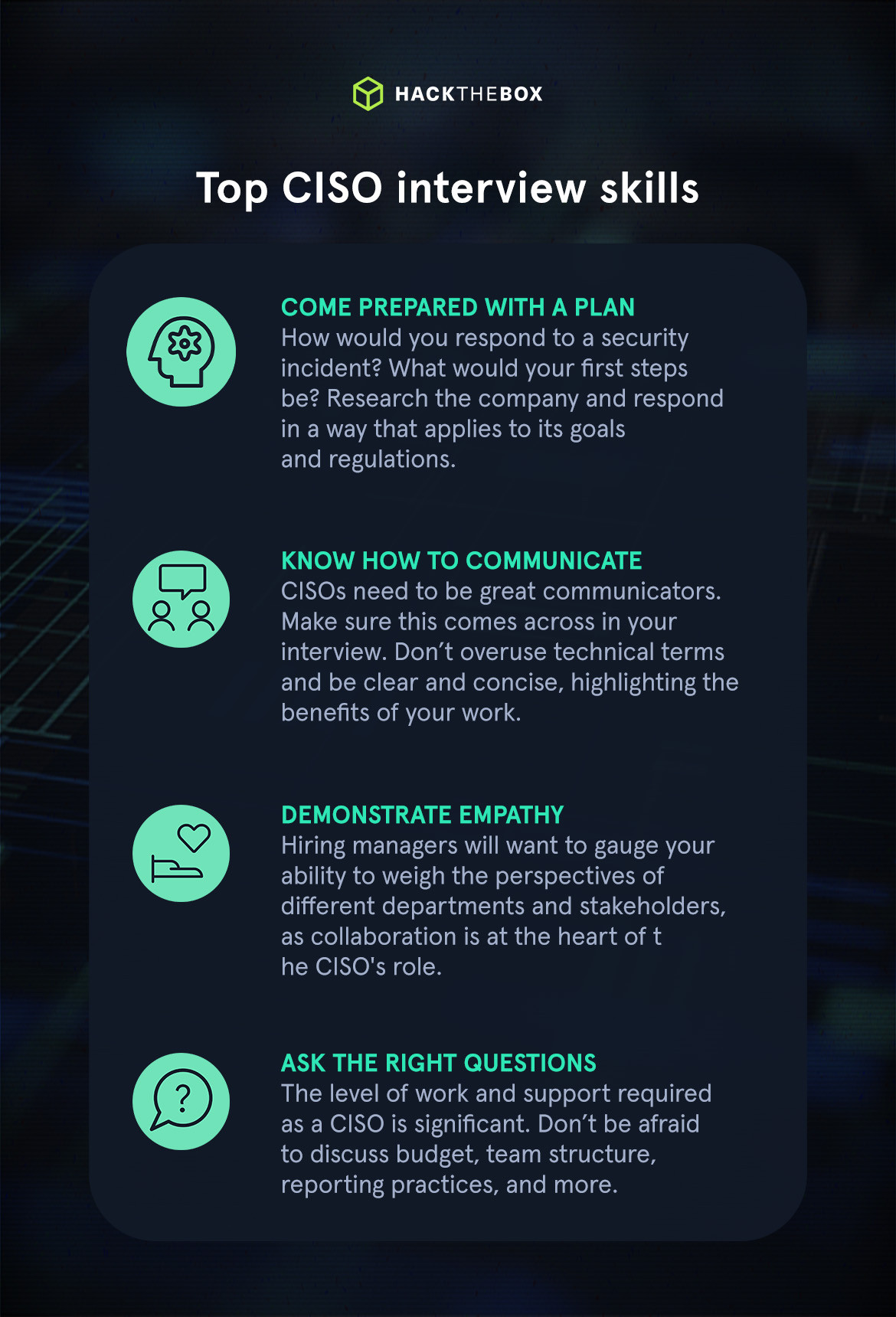
Leadership-focused CISO interview questions
1. Tell me about a time you made a bad decision as a leader.
Being a leader means taking accountability and understanding where and why you made a mistake. CISOs are required to make plenty of decisions, sometimes in a short period, relating to the security of an organization.
These decisions can have serious consequences, which is why learning from past mistakes is important.
For this question, I want to know what the following:
What was the original problem/project.
What the bad decision was.
How you recognized you made the wrong call.
What steps you took to course correct.
What the outcome was (good or bad).
I also want to know how you would mitigate this situation in the future.
Ken Underhill, CISO and multi-award winning and international best-selling author of Hack the Cybersecurity Interview.
2. Describe a time when you had to make a decision and neither option was very good.
Working as a security officer can sometimes require decision-making between a rock and a hard place. When amid a breach, for example, it might be necessary to shut things down to resolve the problem.
This could lead to a loss of customers or reputational damage, but the other option could be worse. Having the ability to make a tough decision can pave the way for a talented CISO.
I want to understand how you employ critical logic when deciding between two difficult options.
Ken Underhill, CISO and multi-award winning and international best-selling author of Hack the Cybersecurity Interview.
3. How do you support cybersecurity teams' well-being and prevent burnout?
Burnout is a well-known issue in cybersecurity due to the demands of the role, the need to be “always on”, and a huge understaffing problem.
CISOs need to pave the way for the well-being of their employees and develop initiatives to combat the growing issue:
I had the privilege of being able to implement several initiatives to combat burnout.
For instance, I encouraged team members to schedule 'no meeting' blocks dedicated to deep work or personal time. I also planned regular check-ins with my team to discuss workloads, motivations, and personal development goals.
These measures had a significant positive impact on team morale and productivity. It’s a commitment I believe should be carried out in any approach to team management, reflecting a sustainable and supportive work environment.
Andrea Succi, CISO at Ferrari Group.
Role-specific security officer interview questions
4. How can a CISO strategically elevate the security of third-party cloud infrastructure, effectively mitigating inherent risks linked to shared cloud resources, runtime security, use of FOSS and supply-chain security, and potential physical security vulnerabilities?
Mrinal Pathak, Security Engineer at Deloitte, suggests the following strategy for CISOs:
To navigate the dynamic cloud landscape and mitigate risks tied to shared infrastructure and expanding attack surfaces, a CISO can orchestrate a robust strategy. This involves adopting a zero-trust architecture, instituting vigilant continuous monitoring, and behavior-based detection and response mechanisms.
Conducting routine security audits and assessments, enforcing dynamic access controls and least privilege principles, and ensuring DevSecOps practices are exercised.
Additionally, the strategy includes conducting cloud-specific top-threat modeling to identify potential attack vectors, leveraging the security features of the cloud provider, and crafting tailored mitigation strategies and response plans for the organization's cloud infrastructure.
5. Can you describe a comprehensive strategy you've implemented or would implement to manage and mitigate cyber risks across an organization? Tell me how you would align this strategy with the organization's broader business objectives.
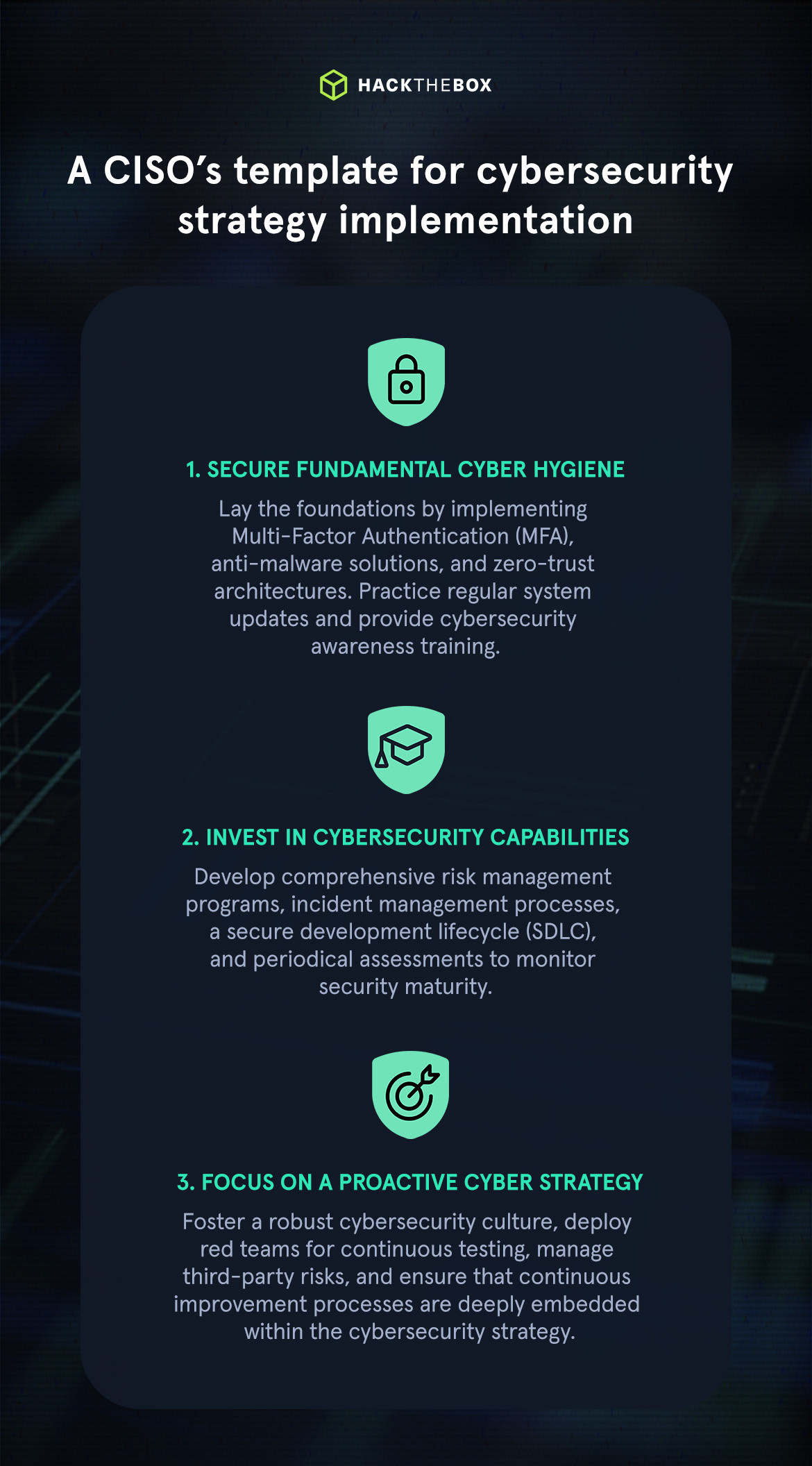
Andrea Succi, CISO at Ferrari Group, provides a brilliant insight into this question:
"In approaching cybersecurity, I believe that a strategy progresses through the company's maturity.
Initially, the focus is on establishing fundamental security hygiene. Here, we implement essential controls such as Multi-Factor Authentication (MFA), anti-malware solutions, and zero-trust architectures while ensuring systems are regularly updated and data is protected.
Once the basics are in place, we advance by investing in key capabilities to make security both repeatable and measurable.
Using frameworks like ISO 27001 or NIST CSF, you should ensure the capabilities are well-rounded, and integrated:
-
Comprehensive risk management programs.
-
Incident management processes.
-
A secure development lifecycle (SDLC).
-
Periodical assessments to monitor security maturity.
The last stage is where we shift focus to proactive and dynamic measures.
This includes fostering a robust cybersecurity culture, deploying red teams for continuous testing and improvement, managing third-party risks effectively, and ensuring that continuous improvement processes are deeply embedded within the cybersecurity strategy."
Throughout all these stages, it’s critical that cybersecurity efforts enable and not hinder the business.
This involves aligning security measures with business objectives, to support growth and innovation and making cybersecurity a business enabler.
The difference between viewing cybersecurity as a cost center versus a business enabler may not be vast in practical terms, but for a CISO and the company, it makes a world of difference.
My strategy ensures that cybersecurity is seen as a value-add that supports the business rather than as a necessary burden.
Andrea Succi, CISO at Ferrari Group.
6. How do you stay up-to-date with the latest security vulnerabilities and attack techniques?
While a CISO leads a team of cybersecurity experts, it doesn’t mean that their foot should be taken off the accelerator when it comes to learning about new CVEs.
CISOs must remain engaged and up-to-date with industry trends, without just relying on their team to keep them informed.
Ben Rollin (mrb3n), Head of Information Security, Hack The Box shares his example answer:
“I use a mixture of passive and active learning to stay updated. Of course, I’m on social media sites like LinkedIn, Twitter and YouTube. I’m intentional about following people who post IT and cybersecurity-focused content.
I also subscribe to newsletters like SANs NewsBites. I’ve found this method is faster than waiting on traditional news and media outlets. It is also fun as I may be sitting on the couch or relaxing while learning.
My favorite resources to follow are:
I also like active learning using sites like Hack The Box because this helps me realize the impact and reality of what is mentioned in the news.
The Academy modules and Boxes that get released are often inspired by recent vulnerabilities that have been discovered in the industry.
Often I may come across a post on Twitter that links to a GitHub repo with a PoC exploit for a vulnerability found in Active Directory or something, and I'll try that PoC in my own home lab. I did this with NoPac when it was first announced.
As soon as I saw it work on my lab domain controller, I immediately started notifying my friends and contacts who lead security teams so they could mitigate.”
7. How do you effectively communicate cybersecurity updates and needs to board members and key stakeholders?
Kunjal Tanna, Co-Founder of LT Harper, a cybersecurity recruitment firm, shared the importance of communicating as a CISO, especially to senior board members:
“When you’re a CISO, what people care about is how you prioritize, how you communicate, and how you influence because that’s ultimately your job.”
You come up with the ideas to make the business more secure. You have to bring different departments and board members along to see the value in making the changes or spending the money to make the business more secure.
Nobody likes change, or spending money, and as a CISO you’re trying to get people to do one or both.
If you’re hiring a CISO you want to know that this is the right person to foster influential relationships. And somebody who can be a chameleon, using the right approach for different board members. To get them to see the value to make their remit easier.
The way you communicate needs to be in a partnership. You should be showing people how you can help them achieve what they’re trying to achieve rather than telling them what they can’t do.
Kunjal Tanna, Co-Founder of LT Harper, a cybersecurity recruitment firm.
CISO soft skills interview questions
8. How do you promote good cyber hygiene throughout your organization?
43% of people have compromised their organization’s cyber security while working. The larger attack surface of most companies calls for CISOs to initiate a culture shift by implementing cyber awareness training across the organization.
You should come prepared with some examples of good cyber hygiene practices:
-
Engaging employees in tabletop exercises to walk teams through a hypothetical attack scenario. Within those exercises, employees across different departments can discuss how the organization would respond to identify gaps in current procedures.
-
CISOs should regularly review previous security incidents with teams, to foster a culture of open communication when it comes to past mistakes. This also teaches employees how to avoid such incidents in the future.
-
Finally, threat intelligence should not only be shared with the cybersecurity team but also with the wider business. This helps to discover new threats to the organization's branch of industry, new attack vectors, and exposed systems.
9. How would you maintain strong relationships with departments outside of cybersecurity?
CISOs are at the helm of cybersecurity and need to help integrate their team into the wider business.
IT and developers are ideal candidates for collaboration with cybersecurity, here are some ways to build these relationships:
-
Cross-training: Provide developers with basic cybersecurity training and vice versa.
-
Collaborative workshops: Conduct joint workshops where developers and cybersecurity experts collaborate to identify and mitigate security vulnerabilities. For instance, organize sessions on secure coding practices or threat modeling, bringing both teams together to discuss real-world scenarios.
-
Incident response planning: Develop an incident response plan that involves both IT, development, and cybersecurity teams. Conduct regular tabletop exercises to simulate security incidents and test the coordination and communication between these teams.
-
Security champions program: Establish a program where members from development teams take on the responsibility of promoting security best practices within their respective teams. These champions can serve as liaisons between development and cybersecurity teams.
10. How do you communicate technical information to a non-technical audience?
This is a question all CISOs and aspiring CISOs need to be prepared to answer as communication is an essential part of the job.
Steve Katz, the first CISO in history, had a brilliant way of communicating with a non-technical audience. In the conversation that eventually secured him a $400,000 budget for a solution, he focused on the business impact of the breach:
“You are sitting in a trading room at a trading terminal and before your eyes, sixes and sevens become nines, fives become eights, and threes become zeros. What does that do to your trade?’”
Steve Katz's hypothetical scenario vividly illustrates the potential chaos and catastrophic financial impacts that can arise from a lack of robust cybersecurity measures.
Here are some things to discuss when communicating technical information with a non-technical audience:
-
Knowing your audience: what are their key concerns and goals? Relating the information to what matters to them is incredibly important. For example, key stakeholders may care about the cost-benefit of security measures, so be sure to communicate this.
-
Use analogies: by providing relatable examples, it’s much easier for a non-technical audience to draw parallels between things that may have initially been confusing.
-
Avoid jargon: technical terms should only be used on a need-to-know basis and jargon kept to a minimum as it can confuse your audience.
-
Use visuals: data, graphs, and infographics are your friends. Non-technical audiences can take in information much quicker when they can visualize it.
11. What are the essential qualities of a great CISO?
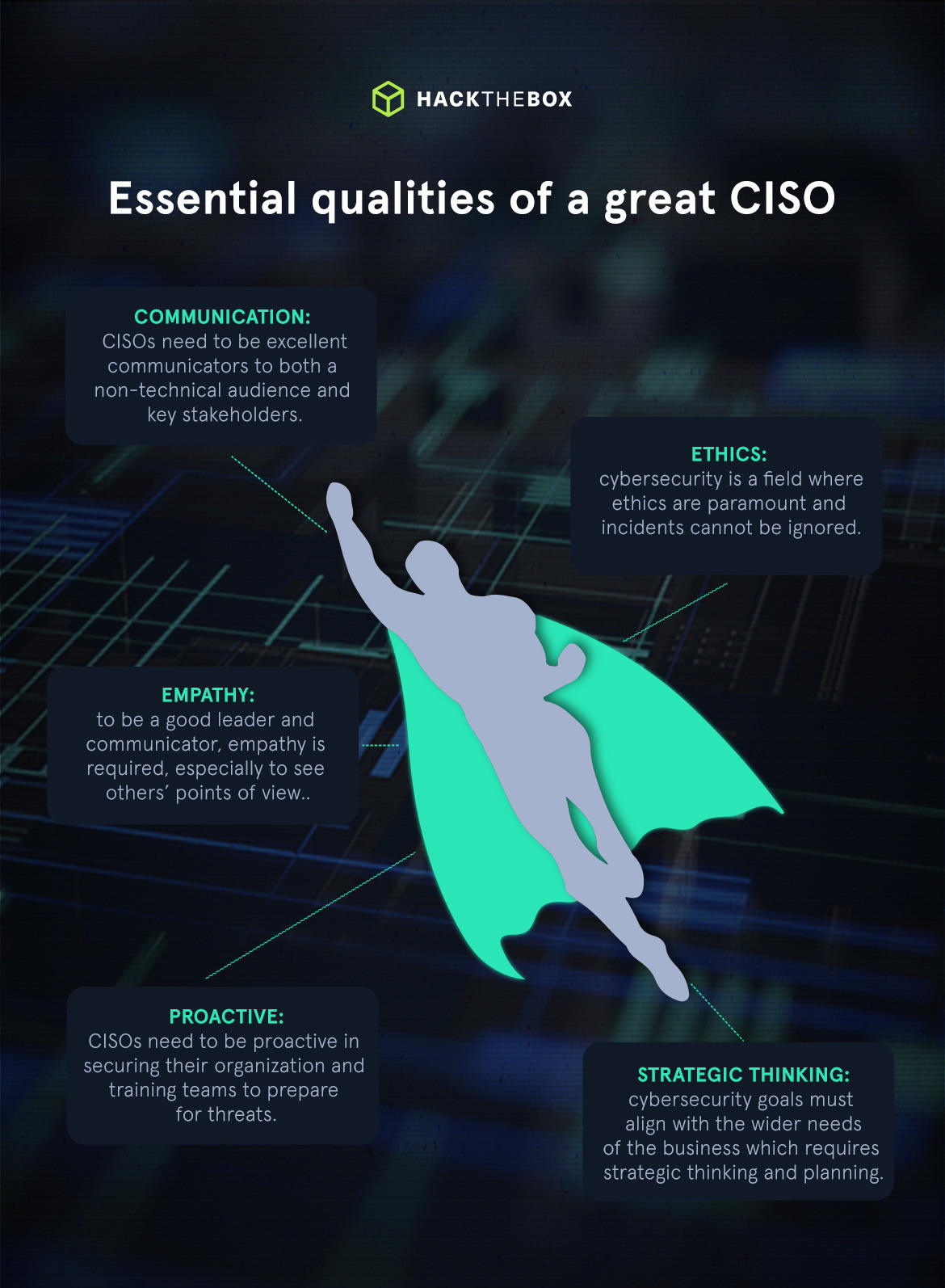
While this is a question that could come up in an interview, it’s also a question you should ask yourself on your journey to becoming a CISO. Perhaps you’ve worked with a great security officer in the past, or have improvements for your existing CISO.
Taking into account your personal experience, share the top traits and why they are important:
-
Communication: as discussed, CISOs need to be excellent communicators to both a non-technical audience and key stakeholders.
-
Ethics: cybersecurity is a field where ethics are paramount and incidents cannot be ignored.
-
Empathy: to be a good leader and communicator, empathy is required, especially to see other’s points of view.
-
Proactive: security is not a field where complacency is an option. CISOs need to be proactive in securing their organization and training teams to prepare for threats.
-
Strategic thinker: cybersecurity goals must align with the wider needs of the business, which requires strategic thinking and planning.
Expert advice from CISOs
Whether you’re on the brink of your first interview for a CISO position, or you’re early in your cybersecurity career searching for tips, Andrea Succi, CISO at Ferrari Group, shares valuable advice to empower your journey:
Embrace an entrepreneurial mindset: Adopt an entrepreneurial approach by framing cybersecurity as an investment rather than a cost. Promote the value of security to the business and demonstrate its positive impact. To do this effectively, invest in your communication and strategic planning skills.
Build a strong network: Networking with other CISOs and cybersecurity professionals is invaluable for exchanging ideas and best practices, gaining support and advice, and staying informed about the latest trends and threats. A strong professional network can also provide diverse perspectives that enrich your approach to security and leadership.
Take care of yourself: Leadership roles in cybersecurity can be incredibly demanding, so it's important to be resilient. Ensure that you maintain a healthy work-life balance to prevent burnout and retain mental clarity. Flexibility in integrating life and work is crucial and should go both ways. Being mentally refreshed means you’ll be more effective when it counts, such as during the management of an unexpected cybersecurity incident.
Questions CISOs may ask during an interview
When interviewing for a CISO role, or any position, it’s important to ask questions, as it demonstrates an interest in the role, while helping you to gain more knowledge about the position.
Here are some important questions to ask during the interview:
-
Who controls the cybersecurity budget and how is it determined? This tells you whether you’ll have the resources to deliver on your role and whether you’ll need to make your case for more budget.
-
Does this role report to the board? To be a successful CISO, you need to be listened to, so it could be a red flag if your role doesn’t report to the board as cybersecurity isn’t viewed as aligned with organizational goals.
-
Is there someone on the board with a skill or interest in cybersecurity? This tells you how experienced an organization is in the field of security and how much of a vested interest the board has.
-
Has the organization experienced any cyber security breaches and how did they respond? As a CISO, you’ll likely experience a breach during your time. So, you want to understand how the company has responded to breaches in the past, to get a glimpse into their culture, ethics, and integrity.
-
How long has the existing cybersecurity team been in place? This can provide insights into your team, how happy they are, where the skill gaps may lie, and how other teams may view cybersecurity.
These questions will give a potential CISO more clarity on their role and what to expect from the position. It’ll also become clear how well-versed the organization is in cybersecurity and if there are any potential red flags.
Cybersecurity needs you!
The industry is in desperate need of skilled CISOs who are capable of bringing security to the forefront of an organization.
If you’re interviewing for a CISO position, you’ve reached a point in your career where you know exactly what support teams need. By leveraging your experience, you’ll be able to make a real difference to cybersecurity teams and influence the key stakeholders to invest more in security.
Not quite there yet? Take a look at our other expert guides on cybersecurity interview questions:
-
30 cybersecurity interview questions and answers (beginner-advanced).
-
15 penetration testing interview questions (answered by experts).
-
18 SOC analyst interview questions (answered by an ex-analyst).
Become an HTB Subject Matter Expert

Are you a cybersecurity professional who wants to contribute to articles like this one?
Join the HTB SME program and you’ll benefit from the following:
-
A huge audience: Our HTB community has over 2.7 million members, giving you a huge platform to share your knowledge with and feature in our editorial content.
-
Networking opportunities: Meet other HTB SMEs and expand your professional network, meeting people you may never have connected with if it wasn’t for your involvement with HTB.
-
Recognition: Any insights you provide will be credited to you, including your name, title, and LinkedIn profile. Some content will get additional love on social media too!
-
Share your experiences: We’re giving a voice to cybersecurity professionals, providing you with a platform to share your knowledge and experiences.
-
Help others: Your unique insights are incredibly valuable to other cybersecurity professionals, or even individuals just starting their careers.
💡Find out more on our blog: Become an HTB Subject Matter Expert
|
Author bio: Fiona Leake (fileake), Content Writer, Hack The Box Fiona Leake is a Content Writer at Hack The Box. Digging deep into how people think to create meaningful content that solves problems is what gets her out of bed in the morning. Fiona loves simplifying technical topics and enjoys occasionally trying her hand at only the most beginner-friendly HTB Machines. Feel free to connect with her on LinkedIn. |
